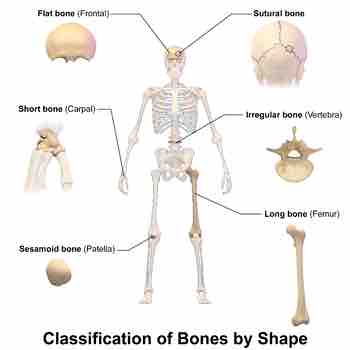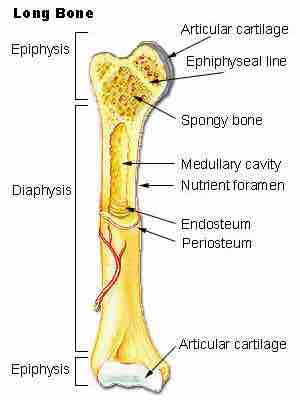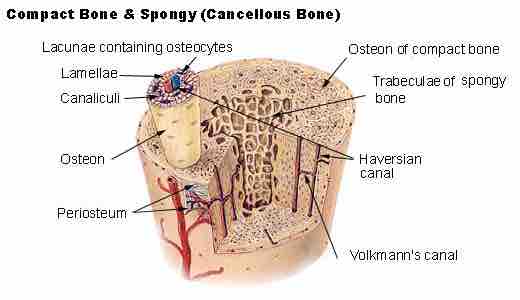Bone Tissue
Bones support and protect the body and its organs. They also produce various blood cells, store minerals, and provide support for mobility in conjunction with muscle. Bone is made of bone tissue, a type of dense connective tissue.
Bone (osseous) tissue is the structural and supportive connective tissue of the body that forms the rigid part of the bones that make up the skeleton. Overall, the bones of the body are an organ made up of bone tissue, bone marrow, blood vessels, epithelium, and nerves.
There are two types of bone tissue: cortical and cancellous bone. Cortical bone is compact bone, while cancellous bone is trabecular and spongy bone.
Cortical bone forms the extremely hard exterior while cancellous bone fills the interior. The tissues are biologically identical but differ in the arrangement of their microstructure.
Bone Cells
The following are the different types of bone cells:
Osteoblasts-involved in the creation and mineralisation of bone
Osteocytes and osteoclasts: These are involved in the reabsorption of bone tissue. The mineralized matrix of bone tissue has an organic component—mainly made of collagen—and an inorganic component of bone mineral made up of various salts.
Bone Types
There are different types of bone. These are:
- Long bones
- Short bones
- Flat bones
- Sesamoid bones
- Irregular bones

Bone types
This image show the different bone classifications, based on shape, that are found in a human skeleton. These are flat bone, sutural bone, short bone, irregular, sesamoid bone, and long bone.
Long Bones
Long bones grow primarily by elongation of the diaphysis (the central shaft), with an epiphysis at each end of the growing bone. The ends of epiphyses are covered with hyaline cartilage (articular cartilage). At the cessation of growth, the epiphyses fuse to the diaphysis, thus obliterating the intermediate area known as the epiphyseal plate or growth plate. The long bones in the body are as follows:

Long bone
A long bone is longer than it is wide. Growth occurs by a lengthening of the diaphysis. located in the center of the long bone.
- Legs: The femur, tibia, and fibula.
- Arms: The humerus, radius, and ulna.
- The clavicles or collar bones.
- Metacarpals, metarsals, phalanges.
The outside of the bone consists of a layer of connective tissue called the periosteum. The outer shell of the long bone is compact bone, below which lies a deeper layer of cancellous bone (spongy bone), as shown in the following figure. The interior part of the long bone is called the medullary cavity; the inner core of the bone cavity is composed of marrow.

Compact bone and spongy bone
The hard outer layer of bones is composed of compact bone tissue, so-called due to its minimal gaps and spaces. Its porosity is 5–30%. Inside the interior of the bone is the trabecular bone tissue, an open cell, porous network that is also called cancellous or spongy bone.
Short Bones
Short bones are about as wide as they are long. These provide support with less movement. Examples of short bones include the carpal and tarsal bones of the wrist and feet. They consist of a thin layer of cortical bone with cancellous interiorly.
Flat Bones
Flat bones are broad bones that provide protection or muscle attachment. They are composed of two thin layers of compact bone surrounding a layer of cancellous (spongy) bone.
These bones are expanded into broad, flat plates, as in the cranium (skull), ilium (pelvis), sternum, rib cage, sacrum, and scapula. The flat bones are named:
- Occipital
- Parietal
- Frontal
- Nasal
- Lacrimal
- Vomer
- Scapula
- Os coxæ (hip bone)
- Sternum
- Ribs
Sesamoid Bone
Sesamoid bones are smaller bones that are fixed in tendons to protect them. An example is the patella (knee cap) located in the patellar tendon. Other examples include the small bones of the metatarsals and the pisiform bones of the carpus.
Irregular Bone
The irregular bones are named for their nonuniform shape. Examples include the bones of the vertebrae. These typically have a thin cortical layer with more cancellous bone in their tissue.